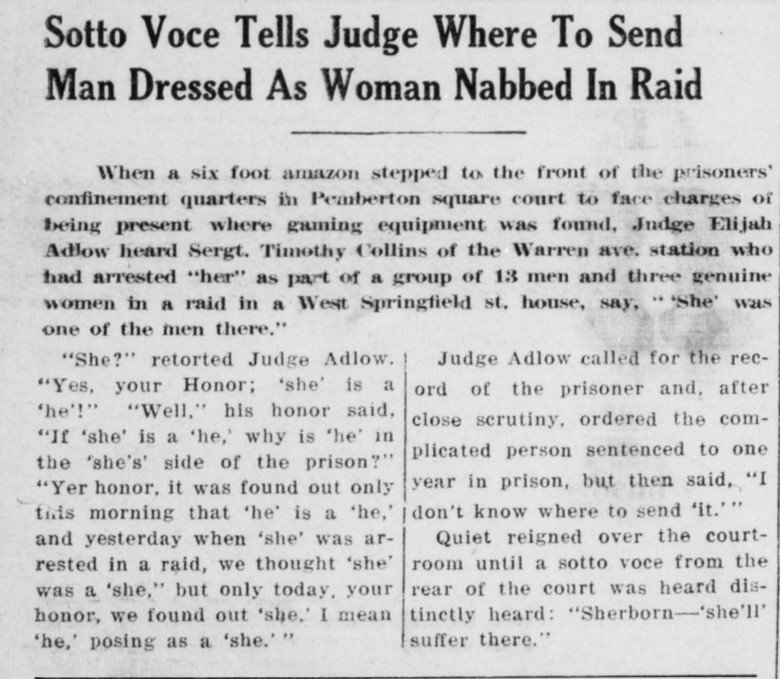
As stated on a previous page, the effects of World War Two on American society and urbanization were consequential. The war uprooted millions of young men and women from small towns into medium to large cities for military training and recruitment and employment in vital wartime industries. Boston was one of many important large east coast cities that served as an important naval base for supplying the Allies in Europe and North Africa. Subsequently, tens of thousands of single men and women relocated to Boston for the war effort.1 Many young gay men and women, having moved from the rural or suburban areas of New England, found Boston to be a haven to explore their sexuality with a degree of anonymity that was elusive in smaller more tight-knit communities.2 With the influx of hundreds of single queer men and women, Boston's pre-war queer subcultures greatly expanded and so did the opportunities for casual sex and relationships with other like minded LGBTQ+ folks.
The graph above shows how queer men overrepresented the queer subcultures in The Mid-Town Journal throughout the 1940s. This would align with the monumental effects that World War Two had on American society. Single men from all across the country were flooding into major cities for employment and military related needs. This influx would suggest that the gay males throughout Boston would have been having more opportunities to socialize and to have sexual relations with other gay men. We can see this appear in the metadata from the journal. There were at several active duty and retired military servicemen who were arrested for having same-sex sexual contact. One article from March 1945 titled, "Intimate Details of Night With Queer Love Cult Revealed In Secret Court Trial; 16 Sentenced For Morals Violations" listed one man who was currently a private in the U.S. Army and another man who had been recently discharged from the U.S. Navy.3 This was a large party that as the title indicates involved many queer men in a private setting which means that there would have likely been many more similar parties that would have gone unnoticed by the authorities.

Two years later, the journal reported on a recently retired U.S. Army Air Force Captain who was arrested for having sexual affairs with a young man.4 This suggests that The Mid-Town Journal was inadvertently documenting the effects that mass mobilization was having on Boston's gay male subculture and the male population at large. A slew of single gay men were beginning to come together now more than ever in places like Boston, forming relationships and networks. World War Two aided in the mass movement of young queer folks into cities where they were now free to explore their sexuality in private spaces. As Michael Bronski reported in A Queer History of the United States, "Homosexuals had undergone a sexual revolution during the war. This revolution contributed almost immediately to a new sense of community, first in the armed forces and then in civilian life. Large cities across the country—especially those on the East and West coasts—saw enormous growth in the number of....gay men."5 Certainly, Boston was conducive for the development of such a gay male subculture.
This map above parallels the home addresses map from the General Findings page. As we can see in the 1940s, many LGBTQ+ individuals were already living in three main clusters of Boston which were the South End, Back Bay and Beacon Hill. This indicates that these areas were quickly becoming known neighborhoods for queer men and women to congregate. It would have meant that the Back Bay, South End and Beacon Hill were relatively safe and to an extent tolerant of LGBTQ+ individuals. Furthermore, the proximity of all three areas perhaps indicates the importance of living close to other known queer neighborhoods. The South End is less than two miles from Beacon Hill with Back Bay being in the middle of the two. Being within walking distance of other LGBTQ+ areas can help forge strong support networks especially for marginalized people who are under constant police surveillance.
Lastly, the map above displays the arrest locations of LGBTQ+ individuals throughout the 1940s. What is noticeable is that the arrests are concentrated from the South End up to Beacon Hill. This overlaps with many of the home addresses that were gathered from the journal. It should be understood that the overlap with the home addresses indicates that many LGBTQ+ persons did not stray far from their home when they went out to meet other queer men and women and to have sexual relations. Living and intermingling North of Lower Roxbury appeared to be the only option for gay men and women in the Boston. The relative compactness of a large city like Boston allowed for a myriad of neighborhoods for LGBTQ+ folks to live in and to exercise a certain amount of anonymous sexual freedom in private spaces and semi-public ones that would have been difficult in smaller more rural New England towns.
Notes
- Improper Bostonians, 129.
- Improper Bostonians, 129.
- Frederick Shibley, "Intimate Details of Night With Queer Love Cult Revealed In Secret Court Trial; 16 Sentenced For Morals Violations," The Mid-Town Journal, March 16, 1945, 1.
- Frederick Shibley, "Former Air Force Captain and Boy, 18, Held As Love Cultists After Beacon Hill Raid," The Mid-Town Journal, January 24, 1947, 1.
- Michael Bronski, A Queer History of the United States (Boston: Beacon Press, 2011), 170.